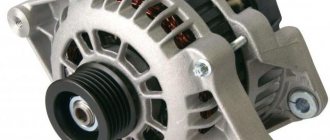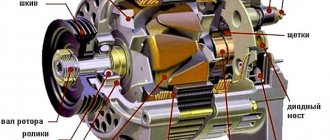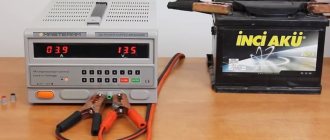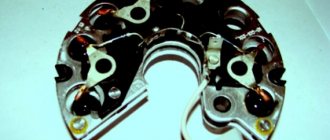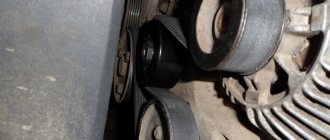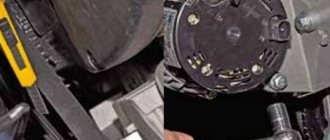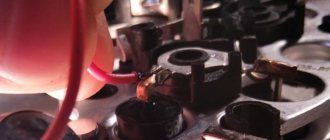Car battery charging voltage from generator
Normally charged battery
– a prerequisite for a comfortable ride.
In the cool season, it is especially important that the battery
ensures reliable starting of the car engine.
Modern cars, especially business class ones, have a battery charging control unit that monitors the main parameters of the process. Economy category vehicles do not have such devices. Experienced drivers do this task without the help of others. Let's look at how to have more complete control over the battery charging
.
Capacity replenishment speed
There is an opinion that for normal battery charging, the charge current should be 10% of its capacity, i.e. with a battery 50 Ampere hours, the charging current will be 5 Amperes. Under these conditions, the battery
will reach its capacity up to 10 hours.
Imagine, you were turned on by the wires of another car in the winter, and in order to fully charge the car battery, you need to drive the car for 10 hours straight, that is, drive about five hundred kilometers.
It is believed that to replenish the battery charge to the nominal value, it is enough to drive 30 kilometers in a normal cycle, and in city traffic jams half that. That is, if your work is located more than 10 kilometers from home, this is enough not to worry about recharging the battery outside the car.
The case is different when work is close to home. You spent the capacity when starting the car, quickly drove to work, and then also home. After a week or two, your battery . And not at all because there is something wrong with the car, it’s just the rhythm of the drive.
In this case, you should think about warming up the engine even in the warm season just to ensure that the battery
was always in a charged state.
Let's return to the charge current. If it is enough to drive a car 30 kilometers to fully charge the battery, and not 500, as in the example, therefore, the charging current of the car generator is not 5 Amperes, but much higher.
Battery life
battery life is more than five years. Used cars imported from abroad have fully working seven- to nine-year-old batteries on board. charging the battery from the generator how to check the charging process is in progress. There, however, the storage conditions for cars are different, and the temperature in winter is higher.
There are three reasons for the low durability of the battery: violation of the battery charging mode, quality of the battery , human factor, in other words, laziness.
Let's start with the first one. If the battery is not charged to full capacity all the time, the plates undergo a sulfation process. Sulfation, or the formation of lead sulfate on the plates, can be compared to a stomach ulcer in humans, only in humans it can be treated, but a battery ulcer is practically untreatable.
There are various methods of complete discharge-charge, charging with pulsed currents. Maybe there is some percentage recovery, but if the battery
I lay down completely, then alas...
The quality of the battery depends on the manufacturer. How to remove the battery on a Ford Focus 2? Modern technologies only affect the increase in battery capacity while reducing the size and weight, respectively, the amount of lead.
How to choose battery ? If there are two different copies with the same capacity, starting current, cost, it is better to buy the one that is heavier, it has more lead, it will last longer.
About the human factor. The biggest mistake car owners make is parking the car in the fall with the battery until spring.
If the battery is
spends it in a discharged, not even fully charged state, and even in the cold with a reduced electrolyte density, it is unlikely to survive until spring.
If you periodically use your car in winter, then regularly (a couple of times a week) you need to start the car and warm it up for at least fifteen minutes, checking the charging voltage.
Checking a car generator
The generator in a car works together with a battery and a relay regulator, and is the “power station” of the car, that is, the main source of electricity. If the generator fails, the battery can become such a source, but only for a short time - without recharging the generator, it will quickly run out.
The relay-regulator in this connection maintains a constant voltage generated by the generator, regardless of the engine speed. Without a regulator at high speeds, the generator voltage would increase sharply, exceeding the voltage for which the electrical consumers in the car are designed.
Sometimes relay regulators are integrated directly into the generator in the form of a small board - a “chocolate bar” in the brush assembly. By the way, if the relay-regulator fails on the road, you can get to the garage if you short-circuit the wires going to the “W” and “+” (VZ) terminals of the relay-regulator through a 20-25 W lamp (for example, from a carrier).
The main, most typical malfunctions of a car generator include interturn short circuit and breakage of the stator or rotor winding, burning of slip rings, brush wear, breakage of the brush holder, damage to the diode bridge, wear of the rotor shaft bearings, breakage of the output terminal wires.
If there are signs of malfunction of the generator or regulator relay, check them
When checking a car generator, diode bridge and relay regulator, you need to be careful, following some rules, so as not to damage these devices
You cannot test the generator by short-circuiting its terminals, that is, using the “spark” method.
Do not allow the generator to operate when consumers are turned off, especially if the battery is disconnected.
Start the diagnosis by checking the tension of the alternator belt.
A loose belt will slip and the generator will not be able to operate properly. Press your finger on the middle of the belt - it should bend no more than 10-15 mm.
Measure the voltage at the battery terminals with a multimeter, then start the car engine and measure the voltage at the terminals again at medium engine speed.
If, when the engine is running, the voltage at the terminals increases slightly, then the generator is working - it provides energy.
The voltage should not rise above 14.5 V (depending on the car model), if the voltage is higher, the relay regulator is faulty. It should be borne in mind that such a check can be considered more or less objective if the car’s wiring is in good order.
If a car alternator is faulty, further diagnostics must be carried out to determine the cause of its failure. Start by checking the diode bridge. To do this, switch the multimeter to the AC current measurement mode and connect it to the “30” or “B+” terminal on the generator and to “ground” with the engine running. The measured alternating voltage should not exceed 0.5 V. If the voltage is higher, then the diode bridge is faulty.
Check the rotor windings (field windings) of the generator.
To do this, remove the brush assembly from the generator and measure the winding resistance by applying the multimeter probes to the slip rings. The resistance should be 5-10 Ohms; if there is no circuit, then there is a winding break.
Measure the resistance between any slip ring and the generator housing - the device should show infinitely high resistance, otherwise the excitation winding will short to ground. Using a similar method, check the stator windings, that is, check them for open circuits and short circuits to ground.
Take measurements with the diode bridge removed.
Inspect the generator brush assembly for brush wear, sticking, etc. If the brushes are heavily worn and protrude from the brush holder by less than 5 mm, then replace the entire assembly, that is, the brush holder along with the brushes.
Checking the generator with a multimeter
https://youtube.com/watch?v=Sn-cawDacAE
PS Generator diagnostics for Ford Focus and preparation for repair. Perhaps it will be useful to someone.
Visual control
Visual diagnostics can and should be done at least once a week.
In summer, it is imperative to monitor the electrolyte level either through the light or through the electrolyte filling holes. If the battery is maintenance-free, monitor the indicator window.
When it goes
the recharging process (the charging current is too high, it is possible when the generator is faulty),
is
boiling away. This leads to an increase in acid concentration, corrosion of the plates, and an even greater increase in current and temperature.
Video - charging voltage of a car battery from a generator, leakage currents and other checks:
Such an avalanche-like process can destroy the battery.
in a couple of hours. Therefore, if you see any changes in the paint above the battery installation site, foreign deposits, or a change in the shade of the battery case near one of the cans or electrolyte refill caps, immediately determine the cause.
If the battery
during constant operation it is not in the green zone, which means that the charging process is disrupted.
How to measure battery charge (vehicle on-board voltage).
how to measure charging
car battery. VKontakte groups: .
The visual method also includes monitoring the “ battery”
" on the dashboard.
If it does not light up when the ignition is turned on, or does not go out after starting the engine, or flickers depending on the engine speed, then the battery charging is disrupted.
Another tip for visually checking the charging process. In the dark, pay attention to the brightness level of the low and high beams when changing engine speed. This is best done by lighting a white wall. If the brightness increases with increasing engine speed, it means that the voltage-current regulator in the generator is not working properly, you need to check the generator.
Generator connection diagram
A generator is the main structural element that serves to convert mechanical energy into electrical energy. A pulley located on its shaft receives rotation from the engine crankshaft. The electrical circuit for charging a battery with a generator includes the following elements:
- battery;
- generating device;
- fuse box;
- ignition;
- dashboard;
- rectifier block;
- diodes.
Operating principle: when the ignition is turned on, the “plus” “sets off”, bypassing the fuses and the diode bridge, and goes to the “minus”. Next, the positive charge moves to the generator winding, while the pulley rotates, like the armature - due to the phenomenon of electromagnetic induction, a current is generated.
Diagnostics using devices
Experienced drivers remember that a garage tool always included a hydrometer and a load fork.
The battery hydrometer is used to measure the density of the electrolyte. Normal density is from 1.23 to 1.28 g/cm3. The lower the temperature, the higher the density must be, otherwise the battery will freeze and fail.
Using a load fork, you can identify a “rotten” can and repair it.
Now the cost of repairs will be more than the cost of a new battery, so these devices are not used in amateur practice.
The most universal device for monitoring battery charging is a multimeter. Sometimes you need to check the battery. Can the battery itself both on the blog and. How can I use it to check the battery charge?
First, before driving with a cold engine, measure the voltage at the battery. It must be at least 12.5 Volts. Turn on the ignition. Normally, the voltage will drop by 0.1 - 0.3 Volts, but still must be at least 12.4 Volts to start the engine.
How to check the operation of the generator
The battery in a car is an important element of the system, which is responsible for providing the car’s on-board network with electricity. The generator is used to charge the battery while it is active. Unstable operation of a device generating electricity causes a voltage drop in the network and failure to restore the capacity of the power source.
Normal generator performance means timely and complete replenishment of the battery charge level, which decreases under load. Checking the battery charge level from the generator is simple and can be done by the car owner himself.
Diagnostics of an automotive energy-generating device includes a visual inspection of the unit, its elements and related parts, as well as voltage and current measurements. At least twice a year, you should check the tension of the drive belt, excessive weakening of which leads to a decrease in the performance of the generator, and sometimes can lead to breakdown of the device. Once a year, you can check equipment elements - fasteners, diode bridge, voltage regulator and others. Timely maintenance of the battery will also guarantee the absence of problems - cleaning the terminals, adding distilled water.
Car generator maintenance
A car generator is a self-sufficient unit that does not require frequent careful maintenance. Its maintenance comes down to just a few operations, including:
- Periodically check the drive belt tension. In the operating instructions, this procedure is usually described separately for each specific car model. Low tension will cause the belt to slip with a characteristic squeak. An over-tightened belt will accelerate bearing wear.
- Blowing away dust and external contaminants. Blow out the generator with compressed air several times a year.
- Cleaning contacts. Monitor the condition and be sure to clean the contacts after oxides appear. Replace terminals and damaged wires as necessary.
- Replacing brushes. Many motorists do not wait for the generator to fail, but change the brushes every few years, depending on the recommendations of the car manufacturer and mileage.
The proper operation of a car generator mainly depends on the initial quality of the unit and the belt tension. Other factors influence to a lesser extent.
You can buy a generator for your car at a competitive price in our online store TopDetal.ru. We also sell components for generators of domestic and foreign production. From us you can order spare parts for generators with delivery by mail throughout Russia.
Expert help
What kind of charging should go to the battery from the generator?
It is traditionally believed that 13.5-14.5V should be supplied by the generator to the battery and this is absolutely enough to replenish the battery costs.
It is worth considering that using a battery with a higher power in a car than the manufacturer recommends also requires the installation of a more productive generating device.
It is necessary to take into account the load that the generator must withstand - it is calculated based on the maximum indicators of all electrical appliances and car systems.
Do not forget that the charging current from the energy-generating device will allow you to start the car in the cold season. In order to avoid problems with starting the car, we recommend purchasing generating equipment, the charge current of which will be approximately 10% of the capacity of the power source. That is, a battery of 100 A/h requires a generator that can produce 10A. Please note that for many cars, 100 amp equipment will operate at its maximum capacity, because the power consumption of the automotive system is in the region of 80 amps. Therefore, the choice of a source generating energy must take into account both the battery capacity and network consumption.
How to check the alternator voltage on the battery
The potential difference can be diagnosed in two ways - directly at the generating equipment and through the battery. The generator is directly connected to the power source with a thick wire, therefore, to check the level of potential difference, you can measure the voltage at the power source. To do this, you will need special devices - a voltmeter, multimeter or load plug.
The wires of the first measuring instruments are connected to the battery in any sequence. The plug must be connected to the battery terminals with strict observance of polarity. It is generally accepted that the normal voltage in the network should not be lower than 12 volts. At idle speed without turning on all the electrical appliances of the car, this indicator should be at the level of 13.5-14V. A drop in voltage values to 13.3-13.8 volts is considered acceptable.
At the same time, using conventional testing equipment, you can check the resistance of the generator elements - rotor, stator and diode bridge. Diagnostics of rotary equipment is carried out by its winding. It is necessary to connect the probes of the device with slip rings. If the multimeter gives readings from 2, 3 to 5.1 ohms, then this element is working. The current consumption of the winding should be within 3-4.5 amperes.
Its normal resistance is 0.2 Ohm. The diode bridge is checked by the presence or absence of resistance, the indicators do not matter. The only thing worth considering is that there should not be a zero dimension. Measurements are carried out in pairs - positive output and all plates on this side or minus and all elements.
We remind you that for normal charging of a car battery, the voltage supplied by the generator must be from 13.5 to 14 volts.
Is it possible to recharge the battery at idle speed?
A question that interests many. It is intuitively clear that if even short trips are not able to restore the battery charge, then it is even more impossible to do this at idle. But don't rush to conclusions.
First, let's look at some well-known facts:
- It takes longer to charge a cold battery than a warm one;
- If the battery is very low, you will only have one try when starting the engine. The second time there is not enough battery energy to crank the starter.
It follows from this that in cold weather when the battery is not fully charged, starting the engine should be taken with the utmost responsibility, otherwise you will have to look for a “donor”.
But if the attempt was successful, we can assume that normal charging will occur only after the engine warms up to 45–50 degrees. This usually takes up to 10 minutes, more at sub-zero temperatures. After this, if you don’t plan to go anywhere, you need to let it run for at least half an hour - this will guarantee that with a working ignition system, your car will start the next day (of course, also on the first try).
How many amperes does a car alternator produce per battery?
The current strength required by the electrical system of each car is individual and depends on the number of electricity consumers and their values. And also the charge current must be sufficient to charge the power source.
It is worth noting that ampere readings appear only when there is a load in the vehicle’s electrical system and, accordingly, the battery is discharged. After starting the car engine, the charging current is about 6-10 amperes and drops over time, because the battery is charging, taking on the main energy consumption. If you turn on additional equipment - headlights, radio or heated mirrors, you can see an increase in the charging current values.
When purchasing a generator, pay attention to its technical characteristics, which the manufacturer indicates on the case - that’s where you will find information about the maximum current that will flow to the battery.
In the table below you can see the approximate current values that the generator shows at different loads.
Table 1. How many amperes the generator produces under load.
Signs of a generator malfunction
In modern cars, breakdowns of the electrical system are one of the most common. A large number of electronics requires particularly careful monitoring of the operation and condition of the generator and battery, because their failure can immobilize the car. The most common signs of a generator malfunction are:
- battery indicator light on the instrument panel;
- unstable operation of the battery (its boiling over or undercharging);
- different intensity of headlights;
- extraneous sounds from the generator.
If you notice incorrect operation of the car, then perhaps the battery charging current from the generator is insufficient.
All malfunctions of electrical equipment, which includes the vehicle’s energy-generating device, are mechanical (deformation or breakage of fasteners, housing, malfunction of bearings, pressure springs, drive belt, etc.) or electrical (winding breaks, diode bridge malfunctions, burnout or wear of brushes , short circuits between turns, breakdowns, etc.).
Don’t write off a non-working generator: find out if there are repair kits and spare parts. Replace them if possible. If you cannot carry out repair work yourself, then take the generator to a workshop. Many craftsmen will be able to restore the unit at no extra cost and in the shortest possible time.
However, some breakdowns require the purchase of a new device that generates electricity. For example, a failing bearing that is soldered into the generator housing cannot be restored or replaced in most cases.
Remember that failure of this unit can be caused not only by wear and corrosion, but also by poor quality of elements and components; excessive load; external influence of salts, liquids, temperatures.
Possible problems
Is your car battery not charging from the alternator even though the car is used regularly? There are many reasons for this. Let's take a closer look at those that motorists most often encounter.
The generator works but does not charge the battery
The battery icon, glowing red on the dashboard when the car is moving, indicates that due to a combination of circumstances, the battery has stopped receiving energy from the generating device. That is, the generator works, but for some reason does not charge the battery. The root cause may be hidden both in the generating device itself and in the battery. Initially, you should determine the reason for the current leak, and in addition, measure the voltage at the terminals, check the level and density of the electrolyte, which in most cases will allow you to identify the culprit of the malfunction. Usually the reason is as follows:
- Burnt fuse. When this happens in the battery circuit, charging will not go directly to the battery; the remaining electrical consumers of the car will operate as normal. In addition, the voltmeter will show the presence of voltage in the on-board network.
- The generator belt is broken or its tension is loose. In such a situation, under load, the generating device will “slip”: the belt slips on the pulley, making whistling sounds. When the headlights are turned on, the indicator on the panel indicating that the battery is low will light up. Eliminate the cause of the malfunction by replacing the belt, adjusting its tension.
- Damage to contacts or wiring. Oxidized battery terminals contribute to current leakage and do not allow the battery to accept charge from the generator. The condition of the contacts should be checked not only on the battery itself, but also on the generating device, as well as on the vehicle’s ground. The oxide is removed by cleaning or with a special lubricant. The generator is connected directly to the battery with a thick wire. If it is damaged or has manufacturing defects, the battery will not be charged.
Charging "jumps"
Sometimes the generator charging current can fluctuate over a wide range. This affects not only the full supply of energy to the battery, but also other consumers: dim headlights, the interior light bulb blinks, the radio operates intermittently. The main reasons for the instability of the amount of incoming charge:
- The generator regulator is faulty. The device, which is a relay, must ensure the voltage of the on-board network is within acceptable limits, regardless of the load, temperature conditions, and shaft speed. The sensor device is nothing more than a conventional electronic circuit with outputs to graphite brushes. Equipment malfunction may be caused by:
- poor contact between wires or a break in the electrical circuit;
- incorrect adjustment;
- short circuit between contacts;
- sintering of contacts, breakage of the armature spring. Damage to the device usually manifests itself in a regular lack of battery charge or, conversely, its excess. You can check the device's functionality using a tester set to voltmeter mode.
- Failure of the diode bridge. The structural element of the generator performs the functions of a collector, replacing it. A bridge circuit is necessary to equalize the ripple of alternating current and convert it to direct current. The main factors leading to failure:
- problems with the battery - low electrolyte density or short circuit of its cans;
- incorrectly performed “lighting” from another car;
- dirt or moisture that has penetrated inside the generator housing.
- instant discharge of a fully charged battery;
- the appearance of whistling sounds from under the hood when starting the engine or while driving;
- a steering fault is displayed on the display and the power steering stops working;
- headlights dim quickly when driving;
- The car radio and air conditioner turn off.
Other causes of low voltage
A small potential difference in the system is not always associated with a breakdown of the generator or a bad battery. If the diagnosis of these elements does not reveal any problems, then you should pay attention to the following:
- condition of the battery terminals - connection density and oxidation;
- electrical wiring problems - oxidation, violation of its integrity;
- output contacts to electrical appliances;
- correctly selected energy consumers.
Each contact must be tightly adjacent and intact, that is, there must be no formations (for example, sulfation) that will disrupt the flow of current. Incorrect connection of contacts leads to accelerated battery discharge even when the car is not running.
To improve the connection of the elements of the car's electrical system, it is necessary to clean all contacts and restore the integrity of the wires by replacing them or connecting them and wrapping them with insulating tape.
In conclusion, I would like to repeat that stable operation of the car requires constant monitoring of all elements, and the generator should attract special attention. The battery is charged from it and provides electricity to the entire car system. Pay attention to all elements: generator brushes, slip rings, voltage regulator, equipment winding.
The most correct measurements should be carried out when the battery is fully charged and in various modes. Remember that the manufacturer links the characteristics of the generator to the number of engine revolutions - they help produce a certain current.
Detailed video on how to check the generator:
Do you have experience diagnosing an alternator and solving problems in a vehicle's electrical system? Please share your experience and opinion with our readers in the comments. If you have questions about the topics covered, we will be happy to answer them.
Well, not so long ago I wrote an article about checking the battery with a load fork , actually this happens for two reasons: when the battery is already dying and needs to be checked, and when the battery is new, it also needs to be tested before purchasing. But is it always the battery? Why might it suddenly fail? It’s one thing if it’s winter and it’s really difficult for him to work, but another thing if it’s summer and he’s not “purr-murr” at all. AND even on the instrument panel, the battery sensor begins to blink occasionally, or is constantly on! In such situations, you should not run headlong for a new battery; first you need to establish the reason why it failed, because in 50% of cases it can be the generator. Moreover, the check is quite easy to do without removing it from the car, let’s read more...
If something is wrong.
- Disconnect the relay regulator (remove the connector). Let's take a tester.
- We set the tester to measure resistance. We check the resistance between ground (engine) and the generator wires (three wires, usually yellow). It shouldn't exist. If at least one has it, your motorcycle's alternator has burned out.
- We check the resistance between the generator wires, the resistance should be the same, about 1 - 3 ohms. If it is more or not the same, your motorcycle's alternator has burned out.
- We set the tester to measure alternating voltage. We start the motorcycle, measure the voltage between the generator wires, it should be more than 18 volts at idle, and more than 40 volts at 3000 - 4000 rpm. If there is no or different voltage, your motorcycle's alternator has burned out.
- If the check in points 2, 3 and 4 went well, most likely your motorcycle has a faulty Relay - Regulator or, which also happens, a wiring fault (clean all terminals, check the integrity of the wires, connections to ground). If your motorcycle's generator burns out, this is the place for you: Rewinding the generator with your own hands.
Our service will help you check the charging of your motorcycle.
Check the integrity of wires and connections.
They will eliminate all problems associated with charging the motorcycle.
If the motorcycle is not sufficiently charged, the following may fail: battery, relay - regulator, generator.
Why does the generator fail?
The generator itself has a simple structure; if you want, it’s a regular electric motor (only made to allow for large current generation), try to spin a regular electric motor and attach a light bulb or LED to it, it will start to light up - and there you have it, an elementary current generator.
Someday I will have an article in which I will tell you what the generator consists of. BUT today it is simple and exaggerated - this is the rotor (moving part), stator (fixed part), brush assembly, relay regulator , and of course the housing in which the whole thing is located.
And now the actual breakdowns.
- The bearings are jammed. This is a fairly common problem with already worn-out generators, the rotor in the housing spins on bearings, from time and moisture (dirt), they wear out and simply jam or wedge. If there is a wedge, then this is one thing - the rod stops rotating. But if wedging occurs, it is difficult to notice; the rod may or may not rotate. In any case, with such symptoms, the belt that turns the generator from the engine is more likely to break. THIS IS THE FIRST CALL.
- The winding on the stator or rotor has burned out. It is there in any case and most likely will be on the stator, so - also from moisture (salt on the roads), it can be corroded and it will simply short out or simply burn out, since copper wires are used there. Accordingly, current generation will stop.
- Failure of the brush assembly. This is also very common, brushes are graphite (often square) rods that run along the stator tracks. So, from time to time they simply wear out and need to be replaced.
- Failure of the regulator relay. This relay prevents the generator from recharging the battery, bringing the voltage and current within the desired range. Often it also fails and the battery does not charge at all! Need to watch.
In general, for these 4 main reasons, the generator may not work, so it must be checked before purchasing a new battery. It's likely that this is what you're dealing with.
Checking the generator on the car
First of all, you need to see if the alternator belt is intact. If it is not torn, then the belt tension is checked. Then it's time for the battery. Using a tester (multimeter), we measure the voltage at the terminals. It should be around 12−12.7 volts. If everything is fine, start the engine. If the battery is discharged, charge it and start the engine again.
We measure the voltage at the battery terminals. It should be within specified limits, usually from 13.2 to 14.5 volts. But on modern cars these limits may differ. If you have an instruction manual, you can read it. Deviation from the specified values in any direction is a malfunction. These deviations can be of three types:
- Lack of charging current - the generator does not work.
- There is a charging current, but below the minimum value - the battery is insufficiently charged.
- Voltage above the maximum value means the battery is overcharged.
All three cases indicate an existing malfunction in the vehicle's electrical supply system. it is necessary to carry out a comprehensive check of the generator.
But before that, conduct a visual inspection of all the wires and cables that go from the generator to the battery. There should be no visible damage, breaks or oxidation of the electrical wiring. Be sure to check the terminals on the battery, starter and alternator. They must be clean and dry. Any oxidation, rust or dirt must be cleaned off. Often this helps restore lost contact and the car begins to work as expected. If this does not help, we proceed to a detailed check.
Using a Multimeter
For further inspection, it is better to remove the generator from the car. First of all, remove the relay regulator from the generator and check it. To check the voltage stabilizer, you will need a multimeter and a charger with regulated voltage. It would be better to use a power supply instead of a charger. Voltage adjustment from 0 to 16 volts will be sufficient.
Connect the plus of the power supply to the regulator - usually this is a male plug connection. Hook the minus to the minus, it is usually output to the ear of the relay mount. Connect the red wire of the tester to the positive wire of the power supply, the black wire to the negative wire. Connect two stripped wires to the brushes, one for each. A light bulb is connected to the other pre-stripped ends (it can be removed from the rear lights of the car during testing). The test bench is ready.
Continuity of the relay regulator
Connect the power supply to the network, carefully use the regulator knob to begin raising the voltage. At the same time, monitor the multimeter readings
The light bulb should not light up at the very beginning, but as the voltage rises it should light up, first at half-incandescence and as the voltage increases, the brightness should increase.
When the 14.5 volt mark is reached, the regulator should operate, cutting off the voltage. The light should then go out. It is generally accepted that the stabilizer is working if it cuts off the current at values from 14.2 to 14.8 volts. If this happens at lower or higher values, then the voltage regulator is faulty. The relay is also faulty if there is no current cutoff at all.
https://youtube.com/watch?v=sYpDunxmZzE
If the relay malfunctions, replace it with a new one. If it is working properly, we continue checking.
Car tips
Actually, I already told you about them from above; if the generator refuses to work, then it is easy to notice even inside the cabin.
- All modern cars will be signaled by a warning lamp - “red battery” on the instrument panel. If it lights up or even blinks, then there is nothing good about it, you need to react immediately, otherwise a discharge is just around the corner.
- Weak glow from all instruments. The “warning lamp” may burn out, but if you notice that the instruments begin to glow dimly, this means that the car is running on the battery, and not on the generator. Again you need to check.
- Belt break. If you crawl under the hood and there you see a break in the belt that spins the generator, then you MUST CHECK THE OPERATION! Otherwise, again, you can kill your battery.
These are all obvious malfunctions, but it happens that the battery is dead and everything seems to be fine, but something inside is “gnawing” - maybe it’s the generator? How to check easily and quickly on a car without removing it? Question? And everything is quite easy here
Check without removing from the car
There are two 100% ways that I personally recommend to you.
1) Check with a multimeter . Of course, not everyone has it, but in fairness it’s worth noting that this is a fairly common device and let’s say your father, neighbor, friend will have it “anyway.” To begin with, we measure with the engine not running, at the battery terminals, the normal voltage should be about 12.5 - 12.7 V, ideally.
We start the car, do not accelerate, and do not turn on any electrical appliances - with the engine running, we measure the voltage, it should be within 13.8 - 14.5 Volts.
However, on modern cars, where a lot of electronics are crammed, manufacturers assure that 14.8 Volts IS ALSO NORMAL. More on this below. Next, we connect the load - headlights, heater, heated rear window, foglights, radio, after that the voltage should drop a little - but not lower than 13.7 - 14.0V. If it is lower, say 12.8 - 13V, then the generator is not working, you need to check it.
Normal battery voltage is 12.5 - 12.7V
After starting the car - 13.8 - 14.5V, on some modern cars - 14.8V
After turning on the maximum load, it should be - 13.7 - 13.8 V
If the voltage is below 13V, urgently CHECK THE GENERATOR
2) The old grandfather's method . You can check this on almost all machines, and this method works 100%. But everything needs to be done very carefully. So - we start the engine, turn on a small load (for example, headlights or heated rear window). And on a working engine, we need to remove the negative terminal from the battery, everything is unscrewed with a key to “10”. We remove it and put it to the side, you can simply lift it above the terminal.
If the car continues to work confidently, the headlights have not dimmed, then your generator is 100% working. If the car stalls immediately, it means that the generator is 100% not working and it urgently needs to be looked at. So I tested it on a VAZ 2101 and now it works on my AVEO.
How to disconnect the battery for the winter?
First you need to loosen the negative terminal, remove it, move it to the side and lock it in the removed position, and only then remove the positive terminal. Do not completely unscrew the terminal fastenings. It is enough just to loosen them and, turning them left and right, carefully remove them without effort.
Interesting materials:
How many balls are there in a bicycle rear sprocket? How much crushed stone and sand do you need for 1 cubic meter of concrete? How much crushed stone is needed per square meter? How many clicks should there be on the handbrake of a VAZ 2110? How many pieces are in one pack of cigarettes? How long does a dumb duck sit? How much does a cormorant eat per day? How many warehouses are there? How many violinists are in the orchestra? How many layers does a Piñata need?
Battery overcharge
However, often it is not “undercharging” and “overcharging”. The electrolyte from the battery boils away and the battery also fails; there is nothing good about this either.
The first sign will be white streaks on the top of the battery, which means the electrolyte simply boils and evaporates. That is, the battery is charged, but the generator still “craps” charging it. The relay regulator has most likely failed here.
The check here is also elementary - you need to connect a multimeter or tester (whatever they call it) with the car running, and look at the charge. If it greatly exceeds 14.5 - 14.8 V, but is within the range of 15 - 15.2 V, it means that it is overcharging. We urgently change the relay-regulator, otherwise you will constantly boil your battery, ALSO NOTHING GOOD. It’s trivial that the plates may crumble.
Now let's watch the video version.
That’s all, he told me, exactly the methods without removing it from the car, and of course give it to a good auto electrician for repairs.
This is where I end, sincerely yours, AUTOBLOGGER.
(
36 votes, average: 4.42 out of 5)

